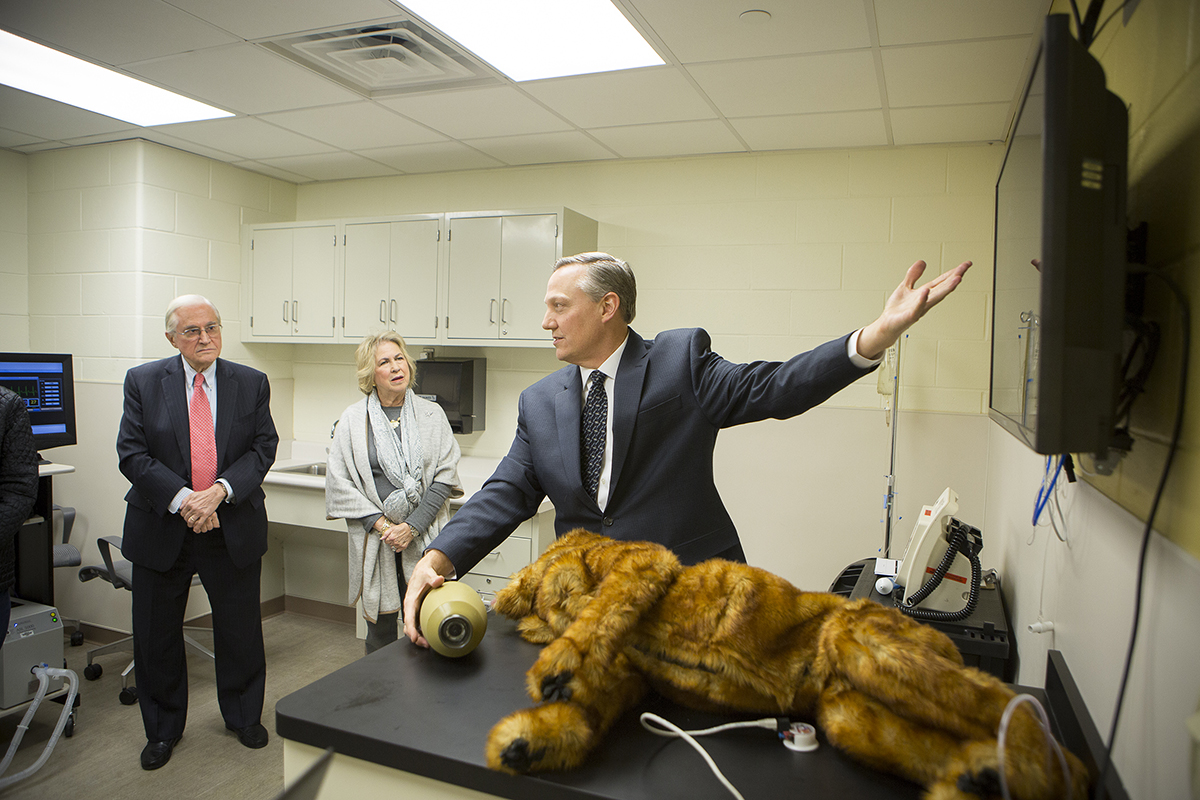Veterinary students train with simulators in new lab
By Claudia Wheatley

What do you get when you cross an engineer with a veterinarian and add a generous dose of support?
You get the Tetlow and Roy Park Veterinary Innovation Laboratory, which functions as a classroom and a workshop that will change the way veterinary medicine is taught. The laboratory was built with generous support from the Parks and the Triad Foundation, and is housed in Cornell University’s College of Veterinary Medicine (CVM).
The lab is the brainchild of Daniel Fletcher, a veterinarian and biomedical engineer who teaches and practices emergency and critical care at CVM and Cornell’s Companion Animal Hospital.
Fletcher the engineer was fascinated with the computer-operated human simulators used to train medical students to address symptoms such as rapid heartbeat and labored breathing. Fletcher the educator wondered why there weren’t animal simulators for veterinary students.
He purchased a human simulator and began stripping it for parts. The first “smart” pet, a dog, debuted in 2010. By 2013, Fletcher was heading a simulation center with “low fidelity” simulators – relevant parts of an animal to teach specific skills like canine cardiopulmonary resuscitation, similar to the ones used in human CPR classes – and “high fidelity” models that look disturbingly real.
The simulators are used throughout the Cornell veterinary curriculum, but they primarily serve to play out emergency scenarios. Teams of students go into a mock exam room where the robotic “patient” awaits, preloaded with symptoms. They have about 10 minutes to absorb the patient’s medical history and vital signs, respond to symptoms like a weak pulse or irregular heartbeat, and figure out the underlying cause. Their efforts are recorded and critiqued by the instructor and the rest of the class.
At the lab’s Oct. 26 dedication, CVM Dean Lorin Warnick observed that the Parks and Triad “were among the first to contribute to Dr. Fletcher’s development of the canine simulator.”
“This is such an important program for us,” Warnick added. “Aside from helping so much on the educational front in preparing our students for emergency care needs, it’s also an example of using alternative technology in teaching, and it’s going to be a trendsetter in veterinary medicine.”
“For me, this is really a dream come true,” Fletcher said. The center began in a CVM basement and moved several times as the college embarked on a massive construction project. Now firmly established in a dedicated space, “Cornell has what I would consider a unique and powerful educational facility that is second to none in the world,” Fletcher said.
Simulation is an ideal way to train adult students, he said.
“It’s a safe environment where students can explore, practice and learn from the mistakes they make while trying to treat what look like real cases,” Fletcher said. “The center will allow learners to get that experience without causing harm to patients and to better prepare them to be ready when they walk into the clinic, and for the rest of their careers.”
Fletcher and his team are creating a new software and hardware platform to drive veterinary simulators that will be available to educators around the world. The new platform will be open source, so users can make improvements and expand the system’s capabilities as they work with it.
“It will have a dramatic impact on veterinary education globally,” said Fletcher. “This is a game-changer in veterinary education, and Cornell is the undisputed leader in this area right now.”
Claudia Wheatley is senior public affairs officer at the College of Veterinary Medicine.
Media Contact
Get Cornell news delivered right to your inbox.
Subscribe